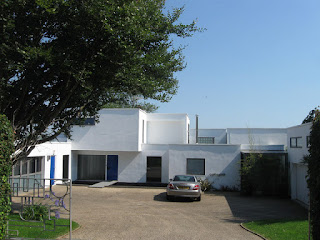Roberto Burle Marx (August 4, 1909, São Paulo – June 4, 1994, Rio de Janeiro) was a Brazilian landscape architect, whose designs of parks and gardens made him world famous. He is accredited with having introduced modernist landscape architecture to Brazil. He was known as a modern nature artist and a public urban space designer.
Marx’s work “can be summarized in four general design concepts—the use of native tropical vegetation as a structural element of design, the rupture of symmetrical patterns in the conception of open spaces, the colorful treatment of pavements, and the use of free forms in water features”. This approach is exemplified by the Copacabana Beach promenade, where native sea breeze resistant trees and palms appear in groupings along Avenida Atlantica. These groupings punctuate Portugese stone mosaics which form a giant abstract painting where no section along the promenade is the same. This “painting” is viewed from the balconies of hotels, and offers an ever changing view for those driving along the beach. The mosaics continue the entire two and a half mile distance of the beach.
He spent a lot of time in the Brazilian forests where he was able to study and explore. This enabled him to add significantly to the botanical sciences, by discovering new rocks and plants for example. At least 30 plants bear his name. Marx was also involved in efforts to protect and conserve the rain forest from the destructive commercial activities of deforestation for bananas and other crops and clear cutting of timber.
Private gardens made for the wealthy elite of Brazil allowed Burle Marx to create small gems of design often flanked by the tropical forest he wished to retain or reinstate. The gardens he created were at the same time artworks, places of relaxation, statements of prestige and a negotiation with the surrounding landscape and tropical vegetation. Many of these places were very much appreciated by their owners and were examples of meticulous maintenance that a public landscape would struggle to attain. At the Edmundo Cavanellas Residence (1954) now the Gilbert Strunk Residence, a river of red foliaged Iresine appeared to flow under a ‘suspension bridge’ created by an Oscar Niemeyer house placed in the bottom of a valley. At this property a dedicated gardener cares for the grid pattern of plain and variegated grasses, once a week using the equivalent of a billhook to separate their root systems as the grasses try to merge into each other. These gardens demand rigorous maintenance to ensure the designer’s vision is retained. A scene that often appears so natural, as at the Mangrove Fazenda, a dream of a garden, is full of detailed care, such as the removal of foliage obscuring the low level flowering of a ginger.
Marx’s work “can be summarized in four general design concepts—the use of native tropical vegetation as a structural element of design, the rupture of symmetrical patterns in the conception of open spaces, the colorful treatment of pavements, and the use of free forms in water features”. This approach is exemplified by the Copacabana Beach promenade, where native sea breeze resistant trees and palms appear in groupings along Avenida Atlantica. These groupings punctuate Portugese stone mosaics which form a giant abstract painting where no section along the promenade is the same. This “painting” is viewed from the balconies of hotels, and offers an ever changing view for those driving along the beach. The mosaics continue the entire two and a half mile distance of the beach.
He spent a lot of time in the Brazilian forests where he was able to study and explore. This enabled him to add significantly to the botanical sciences, by discovering new rocks and plants for example. At least 30 plants bear his name. Marx was also involved in efforts to protect and conserve the rain forest from the destructive commercial activities of deforestation for bananas and other crops and clear cutting of timber.
Private gardens made for the wealthy elite of Brazil allowed Burle Marx to create small gems of design often flanked by the tropical forest he wished to retain or reinstate. The gardens he created were at the same time artworks, places of relaxation, statements of prestige and a negotiation with the surrounding landscape and tropical vegetation. Many of these places were very much appreciated by their owners and were examples of meticulous maintenance that a public landscape would struggle to attain. At the Edmundo Cavanellas Residence (1954) now the Gilbert Strunk Residence, a river of red foliaged Iresine appeared to flow under a ‘suspension bridge’ created by an Oscar Niemeyer house placed in the bottom of a valley. At this property a dedicated gardener cares for the grid pattern of plain and variegated grasses, once a week using the equivalent of a billhook to separate their root systems as the grasses try to merge into each other. These gardens demand rigorous maintenance to ensure the designer’s vision is retained. A scene that often appears so natural, as at the Mangrove Fazenda, a dream of a garden, is full of detailed care, such as the removal of foliage obscuring the low level flowering of a ginger.







Comments
Post a Comment